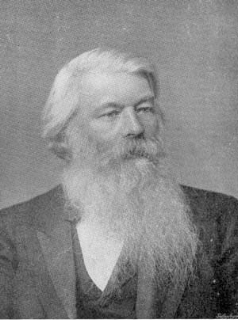Joseph Swan
(1828 – 1914)
Many of the important developments in new technologies of imaging and illumination in the latter part of the nineteenth century were associated with Joseph Swan. Swan was a largely self-educated scientist who developed and marketed photographic dry plates (1877) and bromide paper (1879). He also invented and manufactured an electric light bulb with considerable commercial success, before merging his company with Edison ’s. As early as 1865, Swan had patented a halftone reproduction screen and by the 1890s the techniques he pioneered had been refined to a level where they became commercially viable and aesthetically desirable. Halftone engraving techniques duplicated photographs, paintings, and wash images while line methods were widely used for the printing of pen-and-ink drawings. Collectively these photographic reproduction approaches were known as “process.” By the end of the century, process reproduction techniques replaced the wood-engraving methods that had dominated printed illustration up to this point. Reproduction by process was both quicker and less expensive than wood engraving. Moreover, by removing the interpretive hand of the engraver the photographic processes appeared to be direct conduits for the artist’s individual vision.
In 1885 Swan founded the Swan Engraving Company based in Lambeth, South London. In 1893 the business was renamed the Swan Electric Engraving Company and relocated to Charing Cross Road in London’s West End. Capitalizing on Swan’s profile as a pioneer of electrical lighting the firm boasted: “owing to the perfection of the electrical arrangements, work is carried on regardless of weather, the photography being done with electric light only.” Swan’s eldest son, Donald Cameron-Swan (1863-1951), became a partner and took over the running of the firm, although Joseph Swan continued to be involved until his death in 1914. In 1894 the firm hired the well-known American halftone pioneer Frederick Ives as its technical consultant. Cameron-Swan moved in artistic and literary circles and through these connections undertook the reproduction of the halftones in many of the key works of decorative illustration from Charles Shannon and Gleeson White’s annual The Pageant to The Yellow Book. Aubrey Beardsley (1872-1898), art editor of the initial volumes of The Yellow Book , had become familiar with these techniques in 1892 while working on his illustrations for Dent’s edition of Sir Thomas Malory’s Morte Darthur. In an important essay in The Studio, Joseph Pennell (1857-1926) championed Beardsley’s work and the new processes as indicative of the artistic possibilities of photomechanical reproduction. Although the Swan Electric Engraving Company produced most of the tonal images in The Yellow Book , W. H. Ward & Co., a firm that had broken away from Swan, engraved the last three volumes.
© 2010, Gerry Beegan
Gerry Beegan is an Associate Professor at Mason Gross School of the Arts, Rutgers University, where he teaches design and design history. His research and curatorial interests center on the printed image. Beegan’s writings on the history and theory of reproduction have been published internationally in journals and magazines including Design and Culture , Journal of Design History , Design Issues , Journal of Visual Culture , and dot dot dot . His book, The Mass Image: A Social History of Photomechanical Reproduction in Victorian London , is published by Palgrave Macmillan.
Selected Publications by Joseph Wilson Swan and Donald Cameron Swan
- Swan, Joseph Wilson. Photographic engraving. Letters patent to Joseph Wilson Swan, of Newcastle on Tyne, in the County of Newcastle, Chemist, for the Invention of Improvements in Photographic engraving … London: Patent Office, 1871.
- Swan, Joseph Wilson. Producing printing surfaces and obtaining prints therefrom. Letters patent to Joseph Swan Wilson, of Gateshead, the County of Durham, Chemist, for the Invention of “Improvements in the production of print surfaces by photographic agency and in obtaining prints therefrom … Redhill, 1914. (Originally published in 1865)
- Swan, Donald Cameron. “Photography.” Blackie’s Popular Encyclopaedia . London: Blackie and Sons, 1902.
Selected Publications about Swan
- Clouth, Diane. Joseph Swan, 1828-1914 : a pictorial account of a North Eastern scientist’s life and work . Gateshead: Gateshead Metropolitan Borough Council, 1978.
- Pennell, Joseph. “A New Illustrator.” Studio 1.1 (April1893):14-18.
- Swan, Kenneth Raydon. Sir Joseph Swan . London: Longmans, Green,1946.
- Swan, Mary E. Sir Joseph Wilson Swan, F.R.S. : a memoir / by M. E. S. and K. R. S. London: Ernest Benn, 1929.
MLA citation:
Beegan, Gerry. “Sir Joseph Swan (1828–1914),” Y90s Biographies, 2011. Yellow Nineties 2.0, edited by Lorraine Janzen Kooistra, Ryerson University Centre for Digital Humanities, 2019, https://1890s.ca/swan_bio/.
